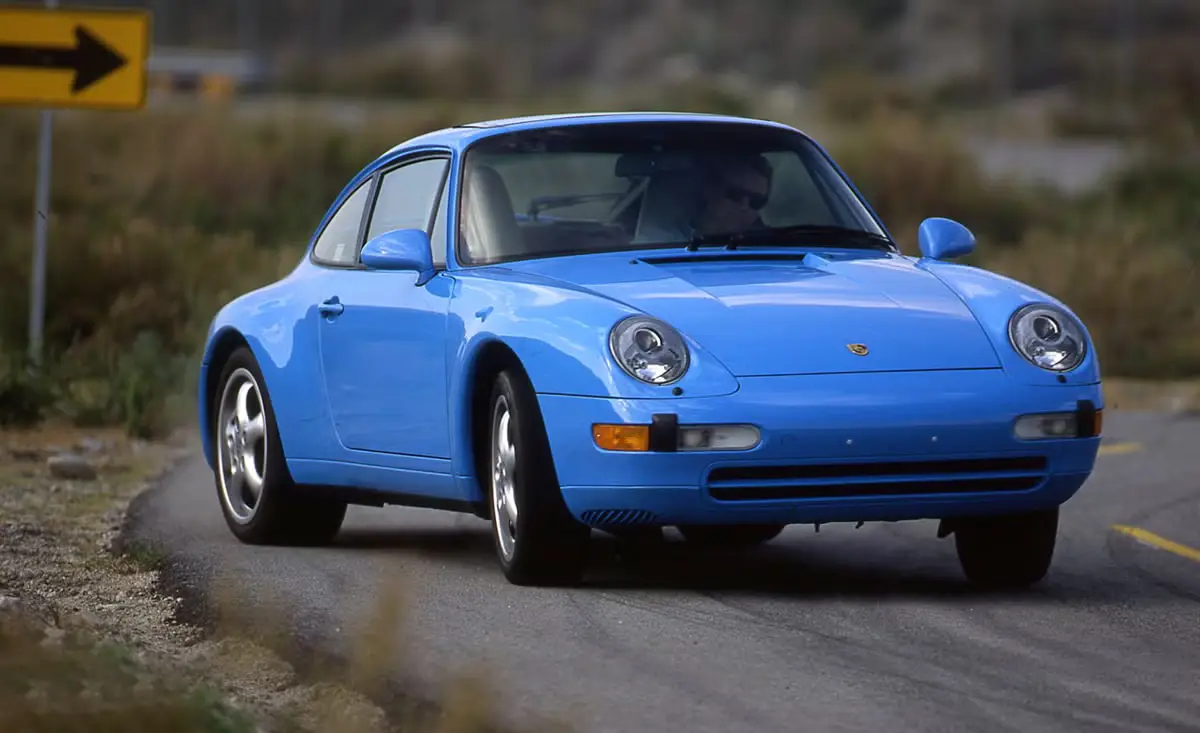The 1995 Porsche 911 weight distribution is more than just a dry technical specification; it’s the very soul of the 993 generation, the reason this car dances on the road with such inimitable grace. For decades, the Porsche 911 has been defined by its unconventional, yet brilliant, rear-engine layout. But by the time the 993 generation rolled around—the final chapter of the air-cooled saga—Porsche engineers had truly perfected the tricky balancing act, transforming a spirited but sometimes challenging layout into a truly sublime driving experience.
993 vs. Its Peers
To underscore the achievement of the 993, let’s briefly compare its weight distribution to other performance vehicles of the era.
| Car Model | Year | Engine Location | Approximate F/R Weight Split | Key Handling Characteristic |
| 1995 Porsche 911 Carrera (993) | 1995 | Rear | 38% / 62% | Legendary on-throttle traction, refined turn-in |
| Ferrari F355 | 1995 | Mid | ~42% / 58% | Neutral handling, high cornering Gs, quick transitions |
| Chevrolet Corvette C4 | 1995 | Front | ~50% / 50% | Balanced, predictable, excellent braking stability |
| Mazda RX-7 (FD) | 1995 | Front-Mid | ~50% / 50% | Highly agile, communicative chassis feel |
| Porsche 964 Carrera | 1990 | Rear | ~37% / 63% | More pronounced ‘pendulum effect,’ demanding |
| BMW M3 (E36) | 1995 | Front | ~51% / 49% | Predictable, linear, easily drifted |
| Acura NSX | 1995 | Mid | ~42% / 58% | Surgical precision, stable at high speeds |
| Dodge Viper RT/10 | 1995 | Front | ~47% / 53% | Raw, huge grip, can be unsettled |
| Porsche 911 Turbo (993) | 1995 | Rear | ~40% / 60% | Exceptionally stable due to AWD system |
| Lotus Esprit S4s | 1995 | Mid | ~40% / 60% | Lightweight, pure steering, low inertia |
A Legacy of Pendulum: Understanding the Rear-Engine Philosophy
To appreciate the brilliance of the 1995 Porsche 911 weight distribution, you first need to understand the challenge. When Ferdinand Porsche first placed the engine behind the rear axle, he solved packaging and traction problems, but he created a dynamic challenge: the infamous ‘pendulum effect.’ In earlier 911s, the heavy rear end meant that if the driver lifted off the throttle mid-corner, the car’s inertia would swing the rear out—a thrilling, but potentially dangerous, characteristic that demanded respect and skill.
The 993, however, was designed to civilize this pendulum while retaining the benefits of rear-engine traction. It’s the moment when Porsche engineering truly coalesced, marking the transition from a powerful brute to a surgical instrument. The key lay in meticulously redistributing every pound of mass. The 993’s sophisticated new multi-link rear suspension (often called the LSA axle) was a game-changer. It allowed the engineers to subtly manage the forces acting on the chassis, ensuring that the driver felt connected, not constantly fighting the car’s natural tendency.
The typical weight distribution for a standard 993 Carrera (non-AWD) is often cited as being close to a 38/62 split (front/rear). While this still looks aggressively rear-biased on paper compared to a modern mid-engine supercar or a classic front-engine GT, it represents a significant, and crucial, shift toward balance compared to its predecessors, where the rear bias was even more pronounced. This slight shift forward of the center of gravity—even by a few percentage points—makes all the difference in steering feel and high-speed stability.
🛠️ Engineering the Magic: How the 1995 Porsche 911 Weight Distribution Was Tamed
The quest for the ideal 1995 Porsche 911 weight distribution involved dozens of subtle changes, none of which were accidental. The goal was to increase the driver’s confidence, especially under tricky conditions.
The LSA Suspension: An Anchor for the Rear
The all-new LSA (Lightweight, Stable, Agile) rear suspension was the most important factor in refining the 993’s handling and managing its inherent weight bias. Unlike the old semi-trailing arms, the multi-link setup offered a phenomenon called “Weissach Effect” control. As the car enters a corner and the suspension compresses, this system subtly introduced a degree of passive rear-wheel steering. This slight toe-in at the rear effectively countered the forces that cause oversteer and tightened the car’s line, making the rear axle feel more planted and less prone to snap oversteer.
Strategic Mass Placement: Millimeters Matter
Porsche engineers were ruthless in their pursuit of optimal balance. While they couldn’t move the 3.6-liter flat-six engine itself much further forward, they manipulated everything else:
- Fuel Tank Location: Keeping the fuel tank as far forward as possible was critical. As fuel is consumed, this helps maintain a slightly more favorable distribution ratio for a longer period of driving.
- Transmission Placement: The lighter, more compact G50/20 gearbox used in the 993 was situated and engineered to be as close to the center of the car as possible, reducing the overall polar moment of inertia—how resistant the car is to turning.
- Component Weight Reduction: The use of lighter materials in the suspension and chassis components meant that the overall unsprung weight was minimized, improving the responsiveness of the wheels to the road surface.
The combination of the advanced suspension and this strategic mass placement meant that the substantial weight still resting over the rear axle could be used as an asset rather than a liability. Under acceleration, the rear-biased weight distribution provides astonishing, almost immediate traction, pushing the car out of corners with phenomenal grip. This is the enduring strength of the 911 layout.
The Driving Experience: A Symphony of Balance
Driving a 993 is a masterclass in dynamic equilibrium. Where older 911s demanded the driver manage the car’s weight, the 1995 Porsche 911 weight distribution in the 993 actively works with the driver.
Consider a high-speed corner on a track day. In a mid-engine car, the cornering feel is immediate and flat, but the limit can be sharp. In a 993, the sensation is different. You feel the engine’s mass settle, pressing the massive rear tires into the asphalt.
“The 993 Carrera feels like a perfectly weighted extension of the driver’s will. The slightly rearward weight bias means you can use the throttle to dictate the car’s exit angle, exploiting the physics that once complicated the drive.”
This handling character is particularly noticeable in the C2 (Carrera 2, rear-wheel drive) models. The rear-end grip under power is legendary, allowing the driver to exit corners with the confidence of a four-wheel-drive machine, but with the communicative steering feel of a pure RWD sports car. For those who wanted even more all-weather stability, Porsche introduced the C4 (Carrera 4, all-wheel drive), which used the AWD system to further optimize the effective weight balance during dynamic driving, though the static 1995 Porsche 911 weight distribution remained fundamentally the same.
As you can see, the 1995 Porsche 911 weight distribution is an outlier in the lineup. While mid-engine cars (Ferrari, NSX) and front-engine cars (Corvette, M3) strive for a near 50/50 balance, the 993 deliberately retained the rear-biased setup to exploit its traction benefits, proving that the numbers alone don’t tell the whole story. The engineering of the suspension is what turns the 62% rear weight from a burden into a performance advantage.
The Turbo and RS: Variations on a Perfect Theme
While the standard Carrera models set the benchmark, it’s worth noting the performance variants also fine-tuned the 1995 Porsche 911 weight distribution.
The 993 Turbo (AWD)
The 993 Turbo introduced all-wheel drive, a system that added weight but fundamentally changed the dynamic distribution. While the static weight split was similar (often slightly more forward due to the addition of the front differential components), the way power was sent to all four wheels dramatically masked and managed the inherent rear bias under acceleration. This made the Turbo one of the fastest and most secure all-weather supercars of its time, delivering immense, usable power without the threat of a sudden break in traction. The stability it provided was unparalleled for a 911 of that power level.
The 993 Carrera RS
The lightweight RS model was the purist’s choice. By stripping out sound deadening, rear seats, and other non-essential items, the overall curb weight was significantly reduced. Crucially, the removal of these items, many of which were located closer to the center of the car, had an impact on the polar moment of inertia, making the car feel even more eager to change direction. The overall goal of the RS wasn’t to radically alter the static 1995 Porsche 911 weight distribution, but to make the car more responsive to driver inputs by cutting mass wherever possible, enhancing the feel of the car’s inherent balance. This focus on lightness amplified the purity of the 993 chassis.
Conclusion
The 1995 Porsche 911 weight distribution is the culmination of decades of engineering mastery. It is the perfect blend of tradition and innovation. The 993 is not just an old car; it is the final, most refined iteration of the air-cooled 911 philosophy, a car that took the inherent challenge of the rear-engine layout and turned it into an unparalleled driving advantage. Its slightly rear-biased nature delivers monstrous traction, while its advanced suspension provides the stability and predictability that eluded earlier generations. The 993 truly earned its title as the king of the air-cooled era by making the unique 1995 Porsche 911 weight distribution a dynamic asset. The result is a truly timeless driving experience.
Frequently Asked Questions (FAQs) about 993 Weight Distribution
Why did Porsche stick with the rear-engine layout for the 911?
Porsche stuck with the rear-engine layout primarily for its exceptional, physics-defying traction under acceleration, especially on slippery surfaces or coming out of corners. The weight of the engine presses the driving wheels (the rears) into the pavement. It also allows for efficient packaging and a distinct, highly-communicative driving character that defines the 911 brand. It’s a key part of the car’s heritage and competitive advantage.
How does the 993’s weight distribution compare to a modern 911 (e.g., 992)?
Modern 911s have seen the engine pushed further forward, and the wheelbase significantly lengthened. A modern 992 Carrera has a weight distribution closer to $39\%/61\%$ or even $40\%/60\%$, inching closer to a more neutral balance than the 1995 Porsche 911 weight distribution of $38\%/62\%$. However, the differences are subtle now, thanks to technological advancements like active suspension (PASM) and torque vectoring, which electronically manage dynamic weight transfer. The 993’s achievement is that it managed this level of control almost entirely through passive mechanical engineering.
Does the rear-engine design affect braking?
Yes, the rear-biased distribution can affect braking. Under heavy braking, the weight shifts heavily to the front wheels, which means the front brakes do a huge amount of work. Porsche engineered the brake system (often with massive discs and calipers) to handle this load transfer.3 The heavier rear can also lead to a slight tendency for the rear to become light, but the sophisticated LSA rear suspension in the 993 was instrumental in mitigating this effect, keeping the rear end stable under deceleration. For more information on the history of this evolution, you can check out the Wikipedia article on the Porsche 911.
Is the 993 more prone to oversteer than a mid-engine car?
Historically, rear-engine 911s were more prone to lift-off oversteer (the rear swinging out when the driver lifts the throttle mid-corner). However, the 1995 Porsche 911 weight distribution, combined with the LSA rear axle, largely solved this problem. The passive rear-wheel steering effect keeps the rear in line, making the 993 far more forgiving and predictable at the limit than its predecessors. While it retains the potential for oversteer, it is a controllable, predictable characteristic rather than a sudden, snap hazard.
I’m Waqas, an electric vehicle enthusiast and tech writer with over 6 years of experience covering the EV industry. I write in-depth articles, comparisons, and reviews to help readers understand the fast-evolving world of electric mobility. From battery technology to EV launches and charging trends, I aim to make complex EV topics simple, engaging, and informative for everyday drivers and curious readers alike.






